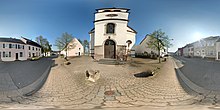Beaumarais
Beaumarais (German Schöner Sumpf , Saarländisch Bómmarä ,) is a district of the district town Saarlouis in Saarland with partly still very village character. Beaumarais had 3607 inhabitants on December 31, 2015.
pronunciation
The French pronunciation is [ bomaˈʀɛ ] (emphasis on the last syllable), the local pronunciation is [ bo'maʀɛ ] (emphasis on the second syllable).
history
When the fortress town of Saarlouis was built in 1680 to protect the new French eastern border, the first construction crews (grenadiers of the French army) settled near the neighboring Wallerfangen and founded the village of Beaumarais in a swampy area.
After completion of the fortress city and the withdrawal of the construction soldiers who were housed in barracks, the civil settlement of Beaumarais began. A special feature was the development of different thicknesses along the main street, which remained in place for over two centuries. Since the village was built, the main focus of construction has been on the western side of the slope facing the Hasenberg. On this side of the street there was an almost closed development. On the other hand, the eastern side facing the swampy meadow area was only very sparsely developed. There were only a few houses in the vicinity of the church. These differently developed buildings on both sides of the street led to the saying in the 20th century: "In Beaumarais, pancakes are only baked on one side". An essential aspect that prevented the development of the eastern side of the road lay in the course of the rayon border of the Saarlouis fortress. During the fortress period, a military-based construction ban was in effect in the rayon. It reached from the road junction at Wallerfanger Strasse to the corner of the building, Hauptstrasse 33, about 260 meters away. In the further course to the south, the road mainly followed the edge of the Bruchwiesen, which can still be recognized today by its slightly winding course. Due to the high groundwater level in the Bruchwiesen, the development remained essentially limited to the areas on the western slope side until the drainage.
Beaumarais was founded in the Ancien Régime on the territory of the Duchy of Lorraine and, like the city of Saarlouis, belonged to a French exclave that was assigned to the canton of Rehlingen in the Moselle department . After the Napoleonic Wars , the area came under the Second Peace of Paris in 1815 to the Prussian Rhine Province , which in turn became part of the German Empire in 1871 .
In 1936 Beaumarais became a district of Saarlouis. During the time of National Socialism , the name of the place was Schönbruch . This is a literal translation of the French name (beau = beautiful, marais = swamp, break).
In the spring of 1937, the so-called Beaumaraiser Siedlung was created under the leadership of the “Gemeinnützige Bau- und Siedlungsgesellschaft” (GBS), which among other things acted as a funding agency. The settlers built 50 single and 15 semi-detached houses, most of which were completed in late autumn 1937. In addition to the 80 settler houses, a grocery store and a kindergarten building were also built.
When the “Beaumarais-Süd” development plan came into effect on July 23, 1971, the city of Saarlouis developed a new 8.5 hectare residential area in which 150 residential units in the form of one and two-family houses were built. The living space directly adjoined the settlement built in 1937. The existing small robinia forests were taken into account in a special way and they were included in the development concept, so that a very varied and very green residential area was created.
education and parenting
The local school children attend the elementary school in den Bruchwiesen in Beaumarais, the younger ones attend the kindergarten in Beaumarais.
Associations and associations
- TUS Beaumarais
- TV 1901 Beaumarais
- Elisabethen Verein, Parish of St. Peter and Paul, Beaumarais
- Beaumarais Fruit and Horticultural Association
- Local interest group Beaumarais eV
- Rancher e. V. Beaumarais
- DRK local association Beaumarais
- German Scouting Association of St George tribe Beaumarais
- Hallelujah Singers eV
- Association for Dialect and History Beaumarais
- TC Beaumarais (M40-3)
Sons and Daughters of Beaumarais
- Josef Reichert (1901–1973), German music teacher, choir director and journalist for Saarland Radio
- Albert Baldauf (1917–1991), German politician ( CDU ), Member of the Bundestag
- Peter Winter, SPD, District Administrator of the district a. D.
- Klaus Pecina, CDU, Mayor of Saarlouis a. D.
- Hans Joachim Fontaine, CDU, retired Lord Mayor D.
- Dora Dimel (1898–1985), commercial graduate student, holder of the Palme Académique and local history researcher
- Hans Nicola (1910–1976), lithographer, painter, graphic artist and photographer
literature
- Dora Dimel: History of the district town of Saarlouis. Volume 2. The history of the Beaumarais district . District town Saarlouis, Saarlouis 1979.
- Association for dialect and history Beaumarais (ed.): The history of the Saarlouiser district Beaumarais. Volume 1 . felten, Saarlouis 2018, ISBN 978-3-9814624-4-9 .
Web links
- Literature on Beaumarais in the Saarland Bibliography
- Homepage of the local DRK association Beaumarais
- Homepage of the scouts in Beaumarais
Individual evidence
- ↑ Geoplatt ( Memento of November 13, 2007 in the Internet Archive )
Coordinates: 49 ° 19 ' N , 6 ° 43' E






